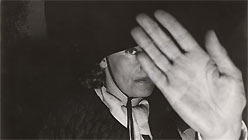Since the time of its invention, photography has had the ability to be an invasive, even violating tool, full of uneven power dynamics. This ethical flaw is also the greatest potential of the medium — photography’s uneasy promise. This conflict is explored in depth in SFMoMA’s provocative new exhibition Exposed: Voyeurism, Surveillance, and the Camera Since 1870, which curator Sandra Phillips has divided into five sections: the unseen, the clandestine photographer, voyeurism and sexual desire, celebrity, and witnessing of violence and suffering.

Tazio Secchiaroli, “Anita Ekberg and Husband Anthony Steel, Vecchia Roma,” 1958.
The title undersells the breadth of the exhibition, incorrectly suggesting an emphasis on the unsuspecting subject. Instead, its scope is broader, and more porous. As ‘celebrity’ bleeds into ‘witnessing of violence and suffering,’ I can’t help but feel the two areas begin to rub up against each other in an uncomfortable and productive way. I’ll leave you to guess which sections Andy Warhol’s 1963 film Blow Job and Yoko Ono’s 1967 film Rape fall into. It’s probably not where you think.

Enrique Metinides, “Suicide rescue from the top of the Toreo Stadium” (detail), 1971.
One of the most effective rooms in the exhibition features the work of American artist Vito Aconcci and the French artist Sophie Calle. Made over a decade apart and in separate continents, the two create an unnerving relationship side by side. Vito Acconci’s Following Piece involved the simple premise of picking out a stranger and following them on the street until they disappeared into a building (either unknowingly, or out of fear of his lurking presence). In her piece The Shadow, Calle enacts the opposite role, hiring an unsuspecting private eye to tail her during a banal day’s activities. The detective’s photos of Calle, along with both of their accounts of the same day (from the perspectives of the watched and the watching, and at one point, the watched doing the watching) form a large grid on the wall. These pieces are deeply unsettling complements, as the male artist enacts the role of the follower and the female that of the followed, even if knowingly. These types of interactions between works are the meat of the show.



